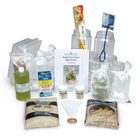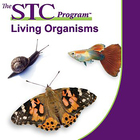Care Guide: Dwarf Aquarium Frogs
Living Care Information
Hymenochirus boulengeri
commonly known as dwarf frog,
African dwarf frog, dwarf clawed frog
Quick Start Information
Dwarf aquarium frogs never need to leave the water.
They can live in small aquaria or other similar containers. Be sure to set up your habitats prior to the arrival of your frogs.
Use conditioned water or bottled natural spring water. Keep the temperature of the habitat stable, between 18 and 25°(64-77°).
Do not place the habitat in direct sunlight.
Dwarf frogs need to be able to access the surface of the water in order to breathe.
About the Organism
- Dwarf frogs are native to the forested parts of equatorial Africa.
- Dwarf frogs should be kept in pairs due to their social nature.
- Dwarf frog mating is called amplexus.
- You may observe your frog burbling— when the frog floats in one spot with its limbs outstretched.
- Dwarf frogs will sleep up to 12 hours a day.
- Domain: Eukarya
- Kingdom: Animalia
- Phylum: Chordata
- Class: Amphibia
- Order: Anura
- Family: Pipidae
- Genus: Hymenochirus
- Species: boulengeri
Preparation
Plan to acclimate your frogs as soon as they arrive. Remove approximately 1 cup of shipping water and replace it with 1 cup of conditioned water from the habitat they will be living in. Repeat after 15 minutes; then, allow the shipping container to sit undisturbed for an additional 15 minutes. Use an aquarium net to gently transfer the frogs to their habitat. Be sure that the water temperature does not vary by more than 1 or 2 degrees. Place your hand over the top of the net to prevent the frogs from jumping out of the net. If using holding containers, be sure to punch air holes in the lids. All dwarf frog habitats should have lids.
Housing
Dwarf frogs can live in small aquaria or other similar containers. You should set up your habitat prior to the arrival of your dwarf frogs. Be sure to use conditioned water. See our general guidelines for information on conditioning tap water. Keep the temperature of the habitat stable, between 18 to 25° C (64 to 77° F). Dwarf frogs need to be able to access the surface of the water to breathe.
Do not place the habitat in direct sunlight. A habitat left in direct sunlight can differ by 5° C above the temperature of the room. At night, such a habitat can cool rapidly, which can stress the frogs and leave them vulnerable to disease. You may wish to add live or plastic aquatic plants to give your dwarf frogs places to rest and hide within their habitat.
Feeding
Dwarf frogs cannot see well and need to have their food placed directly in front of them to recognize that it is there. We recommend using a pair of forceps or a dropper pipette to dispense the food directly in front of the frog. We recommend feeding with brine shrimp flakes. Dwarf frogs will also eat a variety of live foods, including Daphnia or Lumbriculus worms. Both are available from Carolina.
Feed the frogs a pinch of brine shrimp flakes once a day and only as much as they can consume in a few minutes. Live food can be placed in the habitat with the frogs. Remove any uneaten food 5 minutes after each feeding. Any food the frogs do not eat begins to decay and becomes food for bacteria. An overgrowth of bacteria can decrease water quality and put the frogs under stress. Try to remove any uneaten food and perform a partial water change at least once a week.
Maintaining and culturing
Perform partial (25%) water changes of your dwarf frog habitat at least once per week. Use only natural spring water or dechlorinated tap water for water changes. Be sure that the temperature of water you are using to replace the water in the habitat differs by no more than 2° C from the tank’s water temperature. Temperature shock can put the frogs under and make them susceptible to disease.
Disposal
Carolina provides living organisms for educational purposes only. As a general policy, we do not advocate the release of organisms into the environment. In some states, it is illegal to release organisms, even indigenous species, without a permit. The intention of these laws is to protect native wildlife and the environment.
After completing classroom activities, we suggest that organisms be:
- Maintained in the classroom until the end of their life cycle.
- Donated to another classroom or science department.
- With parental permission, adopted or taken home by students.
- Donated to a nature center or zoo.
- Disposed of humanely, as a last resort.
Biosafety
To protect yourself (and/or students) from potential exposure to amphibian or reptile-associated Salmonella infection, wash your hands thoroughly after touching or handling any amphibian or reptile, its housing, or anything (including food) that has come into contact with the amphibian or reptile or its feces. Be sure to wear gloves when cleaning the habitat. It is especially important to keep reptiles and amphibians out of food and drink preparation areas or where food/drinks may be consumed.
Video
FAQs
What should I do with the water in the shipping bag?
Flush the shipping water down the sink. It contains waste products that could harmful to the habitat.
The shipping bags are cold and the frogs are not moving. Are they dead?
Frogs are ectothermic. They become less active when they are cold. Allow time for them to warm to room temperature. Do not apply heat or add warm water. Rapid temperature changes could kill the frogs.
The frogs are probably hungry. Should I feed them right away?
No. Frogs need time to recover and become familiar with their new habitat. Allow 24 hours before attempting to feed your frogs.
How do I know if my frogs are healthy?
Healthy frogs are active and will hide when approached. They also eat voraciously. Check frogs daily and note any change in behavior or appearance.
Anytime you suspect your dwarf frogs are sick, your first step should be to check the habitat’s water conditions with a water test kit. Poor water conditions often cause some symptoms of diseases and can worsen any conditions your frogs may suffer from. For this reason, it is important to perform partial water changes on a regular schedule.
White spots on the frog’s skin may indicate a fungal infection. Anti-fungal medications can help treat this condition. Be sure to remove and quarantine any frog that shows signs of disease before treatment.
Need help?
We want you to have a good experience. Orders and replacements: 800.334.5551, then select Customer Service. Technical support and questions: caresheets@carolina.com


















